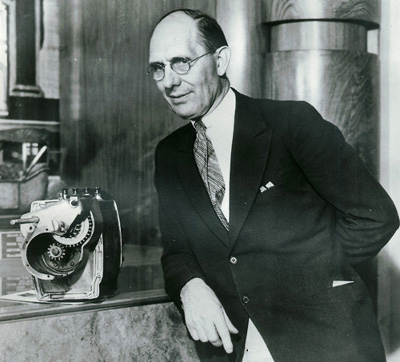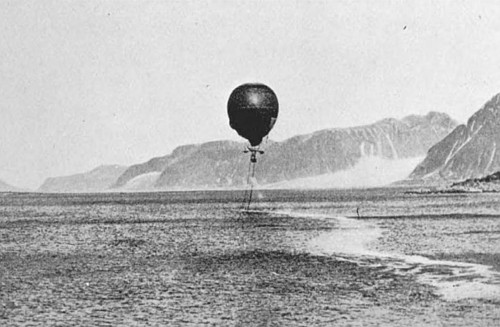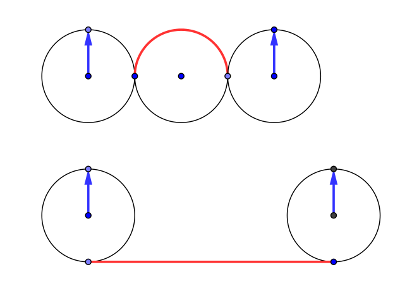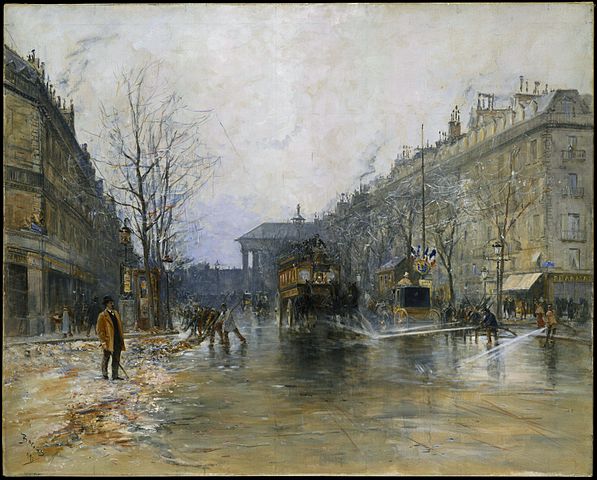
“An inventor is simply a fellow who doesn’t take his education too seriously.” — Charles F. Kettering

“An inventor is simply a fellow who doesn’t take his education too seriously.” — Charles F. Kettering
Between 1868 and 1870, Mark Twain traveled more than 40,000 miles by rail, dutifully buying accident insurance all the while, and never had a mishap. Each morning he bought an insurance ticket, thinking that fate must soon catch up with him, and each day he escaped without a scratch. Eventually “my suspicions were aroused,” he wrote, “and I began to hunt around for somebody that had won in this lottery. I found plenty of people who had invested, but not an individual that had ever had an accident or made a cent. I stopped buying accident tickets and went to ciphering. The result was astounding. The peril lay not in traveling, but in staying at home.”
He calculated that American railways moved more than 2 million people each day, sustaining 650 million journeys per year, but that only 1 million Americans died each year of all causes: “Out of this million ten or twelve thousand are stabbed, shot, drowned, hanged, poisoned, or meet a similarly violent death in some other popular way, such as perishing by kerosene lamp and hoop-skirt conflagrations, getting buried in coal mines, falling off housetops, breaking through church or lecture-room floors, taking patent medicines, or committing suicide in other forms. The Erie railroad kills from 23 to 46; the other 845 railroads kill an average of one-third of a man each; and the rest of that million, amounting in the aggregate to the appalling figure of nine hundred and eighty-seven thousand six hundred and thirty-one corpses, die naturally in their beds!”
The answer, then, is to avoid beds. “My advice to all people is, Don’t stay at home any more than you can help; but when you have got to stay at home a while, buy a package of those insurance tickets and sit up nights. You cannot be too cautious.”
(Mark Twain, “The Danger of Lying in Bed,” The Galaxy, February 1871.)

In 1897, Swedish patent engineer S.A. Andrée set out in a quixotic bid to reach the North Pole in a hydrogen balloon, departing from Norway with two companions and hoping to drift over the top of the world and come down somewhere in the Bering Strait. Instead the expedition vanished. In this episode of the Futility Closet podcast we’ll learn what happened to the Eagle and its three brave passengers, and consider the role of hindsight in the writing of history.
We’ll also learn what the White House planned to do if Neil Armstrong became stranded on the moon, and puzzle over why seeing a plane flying upside down would impact a woman’s job.

In the top figure, one coin rolls around another coin of equal size.
In the bottom figure, the same coin rolls along a straight line.
In each case the rolling coin has made one complete rotation. But the red arc at the top is half the length of the red line at the bottom. Why?

In ordinary life we shift frequently between observing the world before us and summoning impressions from memory. Reproducing this experience in fiction can require an immense sophistication of the reader. In Narrative Discourse: An Essay in Method (1983), Gérard Genette examines a passage from Proust’s Jean Santeuil in which Jean finds the hotel in which lives Marie Kossichef, whom he once loved, and compares his impressions with those that he once thought he would experience today:
“Sometimes passing in front of the hotel he remembered the rainy days when he used to bring his nursemaid that far, on a pilgrimage. But he remembered them without the melancholy that he then thought he would surely someday savor on feeling that he no longer loved her. For this melancholy, projected in anticipation prior to the indifference that lay ahead, came from his love. And this love existed no more.”
Understanding this one paragraph requires shifting our focus between the present and the past nine times. If we designate the sections by consecutive letters, and if 1 is “once” and 2 is “now,” then A goes in position 2 (“Sometimes passing in front of the hotel he remembered”), B goes in position 1 (“the rainy days when he used to bring his nursemaid that far, on a pilgrimage”), C in 2 (“But he remembered them without”), D in 1 (“the melancholy that he then thought”), E in 2 (“he would surely some day savor on feeling that he no longer loved her”), F in 1 (“For this melancholy, projected in anticipation”), G in 2 (“prior to the indifference that lay ahead”), H in 1 (“came from his love”), and I in 2 (“And his love existed no more”).
This produces a perfect zigzag: A2-B1-C2-D1-E2-F1-G2-H1-I2. And defining the relationships among the elements reveals even more complexity:
If we take section A as the narrative starting point, and therefore as being in an autonomous position, we can obviously define section B as retrospective, and this retrospection we may call subjective in the sense that it is adopted by the character himself, with the narrative doing no more than reporting his present thoughts (‘he remembered …’); B is thus temporally subordinate to A: it is defined as retrospective in relation to A. C continues with a simple return to the initial position without subordination. D is again retrospective, but this time the retrospection is adopted directly by the text: apparently it is the narrator who mentions the absence of melancholy, even if this absence is noticed by the hero. E brings us back to the present, but in a totally different way from C, for this time the present is envisaged as emerging from the past and ‘from the point of view’ of that past: it is not a simple return to the present but an anticipation (subjective, obviously) of the present from within the past; E is thus subordinated to D as D is to C, whereas C, like A, was autonomous. F brings us again to position 1 (the past), on a higher level than anticipation E: simple return again, but return to 1, that is, to a subordinate position. G is again an anticipation, but this time an objective one, for the Jean of the earlier time foresaw the end that was to come to his love precisely as, not indifference, but melancholy at loss of love. H, like F, is a simple return to 1. I, finally, is (like C), a simple return to 2, that is, to the starting point.
All in a passage of 71 words! And Genette points out in passing that a first reading is made even more difficult because of the apparently systematic way in which Proust eliminates simple temporal indicators such as once and now, “so that the reader must supply them himself in order to know here he is.”
Army ants are blind; they follow the pheromone tracks left by other ants. This leaves them vulnerable to forming an “ant mill,” in which a group of ants inadvertently form a continuously rotating circle, each ant following the ones ahead and leading the ones behind. Once this happens there’s no way to break the cycle; the ants will march until they die of exhaustion.
American naturalist William Beebe once came upon a mill 365 meters in circumference, a narrow lane looping senselessly through the jungle of British Guiana. “It was a strong column, six lines wide in many places, and the ants fully believed that they were on their way to a new home, for most were carrying eggs or larvae, although many had food, including the larvae of the Painted Nest Wasplets,” he wrote in his 1921 book Edge of the Jungle. “For an hour at noon during heavy rain, the column weakened and almost disappeared, but when the sun returned, the lines rejoined, and the revolution of the vicious circle continued.”
He calculated that each ant would require 2.5 hours to make one circuit. “All the afternoon the insane circle revolved; at midnight the hosts were still moving, the second morning many had weakened and dropped their burdens, and the general pace had very appreciably slackened. But still the blind grip of instinct held them. On, on, on they must go! Always before in their nomadic life there had been a goal — a sanctuary of hollow tree, snug heart of bamboos — surely this terrible grind must end somehow. In this crisis, even the Spirit of the Army was helpless. Along the normal paths of Eciton life he could inspire endless enthusiasm, illimitable energy, but here his material units were bound upon the wheel of their perfection of instinct. Through sun and cloud, day and night, hour after hour there was found no Eciton with individual initiative enough to turn aside an ant’s breadth from the circle which he had traversed perhaps fifteen times: the masters of the jungle had become their own mental prey.”

Auric and I played all that Satie had written for the piano; one of us would play with him what he composed for four hands. Once, after we had played Morceau en forme de poire, I asked our hero, whom we called mon bon Maître, why he gave such a title, Pieces in the shape of a pear, to this ravishing music. He answered with a twinkle in his eyes: ‘You do know that I visit Debussy quite often; I admire him immensely and he seems to think much of whatever talent I may have. Nevertheless, one day when I showed him a piece I had just composed, he remarked, “Satie, you never had two greater admirers than Ravel and myself; many of your early works had a great influence on our writing. … Now, as a true friend may I warn you that from time to time there is in your art a certain lack of form.” All I did,’ added Satie, ‘was to write Morceau en forme de poire. I brought them to Debussy who asked, “Why such a title?” Why? simply, mon cher ami, because you cannot criticize my Pieces in the shape of a pear. If they are en forme de poire they cannot be shapeless.’
— Vladimir Golschmann, “Golschmann Remembers Erik Satie,” High Fidelity/Musical America, August 1972
(Thanks, Dan.)
The theme music for the British television series Inspector Morse starts with a motif based on the Morse code for the word Morse:
-- --- ·-· ··· ·
“It was just a little in-joke,” composer Barrington Pheloung told Essex Life & Countryside in 2001. “I put his name at the beginning and then it recurred all the way through.”
Encouraged, he carried the idea into subsequent episodes. “Sometimes I got a bit cheeky and spelled out the killer’s name in the episode. In the episode ‘WHOK,’ which was a bit of an enigma, the culprit was called Earle. So he got plastered all over the orchestra.” When viewers caught on to this, occasionally he’d insert another character’s name to fool them.
And sometimes he’d give them the slip entirely. When the episode aired in which the detective was due to reveal his first name, 20 million people tuned in to listen for clues in the music, and a national newspaper enlisted the Royal College of Signalling to decipher the notes. They found nothing. (The inspector’s name is Endeavour.)
(Thanks, Dave.)
UPDATE: In the same spirit, the theme to the 1970s British sitcom Some Mothers Do ‘Ave ‘Em (below) spells out the series’ title in Morse code (minus the apostrophes). (Thanks, Nick.)
https://www.youtube.com/watch?v=ICnl_7u0sp8
1!, 22!, 23!, and 24! contain 1, 22, 23, and 24 digits, respectively.
266!, 267!, and 268! contain 2 × 266, 2 × 267, and 2 × 268 digits, respectively.
2,712! and 2,713! contain 3 × 2,712 and 3 × 2,713 digits, respectively.
27,175! and 27,176! contain 4 × 27,175 and 4 × 27,176 digits, respectively.
271,819!, 271,820!, and 271,821! contain 5 × 271,819, 5 × 271,820, and 5 × 271,821 digits, respectively.
2,718,272! and 2,718,273! contain 6 × 2,718,272, and 6 × 2,718,273 digits, respectively.
27,182,807! and 27,182,808! contain 7 × 27,182,807, and 7 × 27,182,808 digits, respectively.
271,828,170! 271,828,171!, and 271,828,172! contain 8 × 271,828,170, 8 × 271,828,171, and 8 × 271,828,172 digits, respectively.
2,718,281,815! and 2,718,281,816! contain 9 × 2,718,281,815, and 9 × 2,718,281,816 digits, respectively.
27,182,818,270! and 27,182,818,271! contain 10 × 27,182,818,270 and 10 × 27,182,818,271 digits, respectively.
271,828,182,830! and 271,828,182,831! contain 11 × 271,828,182,830, and 11 × 271,828,182,831 digits, respectively.
The pattern continues at least this far:
271,828,182,845,904,523,536,028,747,135,266,249,775,724,655!, 271,828,182,845,904,523,536,028,747,135,266,249,775,724,656!, and 271,828,182,845,904,523,536,028,747,135,266,249,775,724,657! contain 59 × 271,828,182,845,904,523,536,028,747,135,266,249,775,724,655, 59 × 271,828,182,845,904,523,536,028,747,135,266,249,775,724,656, and 59 × 271,828,182,845,904,523,536,028,747,135,266,249,775,724,657 digits, respectively.
(By Robert G. Wilson. More at the Online Encyclopedia of Integer Sequences. Thanks, David.)
Detractors of Massachusetts governor Endicott Peabody said that three of the state’s towns had been named for him: Peabody, Marblehead, and Athol.